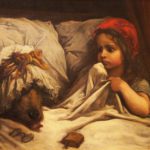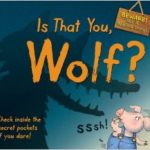
“Well,” I hear you say. “Why would I want to let my kid read horror anyway?” Because life is scary, and kids know this. Even if we, as parents and guardians, like to pretend we don’t know they know. Reading horror lets younger readers know that, no matter what real life horror they may be dealing with in their own lives (and to kids even an argument at home can seem fairly horrific), there are much scarier things to be found in books, and maybe they can find some comfort in that.
When do we let our kids start reading horror? Too young and they may become traumatised. Leave it too long and they may never appreciate a scary story. Is there a right answer to the question? Of course there is. The answer is: when you as the parent/guardian feel it’s right for your child. Some kids mature quicker and maybe excel at reading so they can handle Stephen King and Shirley Jackson at a younger age than their peers. And some kids take a little longer to catch the reading bug.
In this short article I am going to use my personal experiences to offer an example of how I am introducing my six-year-old daughter, Emily, to darker tales. As I’ve stated, this is subjective. It depends on each child. This is just one way.
I should start by stating: I don’t have a grand plan. There is no formula. I didn’t sit down when Emily was born and say: “By the age of four I will be reading these stories and by the age of six I will be reading those stories …” I think that most parents begin their career as storytellers with some of the oldest dark tales we have. And we all know some of these. They are fairy tales, passed from generation to generation in one form or another. They can differ from region to region, country to country, but most contain some element of the fantastic or scary. And I believe kids crave these things. It introduces them to the idea that, in a story at least, anything is possible, from the wonderful to the horrific. Imagination is limitless.

Then there is The Three Little Pigs. Our version begins with the title characters leaving their family home and building homes of their own. The first is gobbled up by the Big Bad Wolf because his house of straws was not strong enough to repel the attacker. The second is also gobbled up after the Wolf blows down his house of sticks. But when the Wolf fails to blow down the brick house of the third pig, he tries to come down the chimney, lands in a pot of boiling water and is cooked and eaten by the pig. Wolves tend to get a bad rep in fairy tales but they are perfect candidates for the bad guy role. Natural predators, with powerful jaws and huge teeth, they are a lot of fun for parents to portray when scaring their kids.

The summer before Emily began school, I decided that she was ready for a longer bedtime story. As with most things, I called upon my own reading experiences as a child and remembered the enjoyment I felt when reading any book by Roald Dahl. Here is a storyteller who seemed to be able to tap into the mind of a child and know exactly how to write entertaining and sometimes horrific tales that would excite a young reader. His protagonists were mostly children that the young reader could relate to, whether it was the chocolate-loving Charlie, or the story-loving Matilda, or the animal-loving unnamed protagonist from The Magic Finger. And they could also relate to the hero’s victory over evil. The antagonists were often grown-ups who abused their position of power to mistreat children. In such instances Dahl would always relate the horror of the situation to the reader in vivid detail.
Take Matilda, for example. I loved reading this to my daughter before she started school. The story of a bright, intelligent, clever young girl who discovers the magic of books at a young age. I admit I hoped to inspire Emily. But I did worry that it might give her the wrong impression of school. When Matilda starts school, we are introduced to the Headmistress, Miss Trunchbull, described as “… a gigantic holy terror, a fierce tyrannical monster …”. Here is a woman whose idea of enforcing her rules on how a female student may style her hair involves lifting the girl up by her offensive pigtails, swinging her around her head and launching her over the school fence. One student, called Hortensia, relays the story of how the Trunchbull locked her in ‘the Chokey’, a tall, narrow cupboard with glass stuck to the three interior walls and nails driven through the door so that any student who finds themselves locked inside must stand for the duration. It is a form of punishment more suited to a medieval torture chamber than a primary school. Fairly horrific for a four-year-old.
One of the scenes from a Roald Dahl book to have a real effect on Emily is found in The BFG. The young protagonist, the orphan Sophie, is talking with the eponymous Big Friendly Giant in his cave when they are interrupted by the horrible Fleshlumpeater, leader of the other man-eating giants. In her haste to hide, Sophie seeks refuge in a foul-smelling vegetable called a Snozzcumber. Not knowing this, the BFG tries to goad the Fleshlumpeater to eat the Snozzcumber and become so disgusted he will leave the cave. The fearsome giant takes the bait, and proceeds to bite off the end of the vegetable, the end with Sophie inside. The way Dahl built up to the climax of this scene had Emily on tenterhooks. Being of a similar age to the protagonist, she was able to imagine herself in this terrifying position and she did not know how the scene would play out. Plus, with a group of man-eating giants including the Bloodbottler, the Childchewer and the Bonecruncher, described in great detail, it is clear that Dahl wants to scare the young reader. I think he succeeded, at least with my own young reader.
One book that I read when I was a child that I haven’t read to my daughter yet is a book by Dean Koontz, entitled Oddkins: A Fable for All Ages. It is considered a Gothic Fantasy and concerns a magic toymaker who passes away, leaving a group of his toys, led by Amos the bear, to find his chosen successor before an evil toymaker takes over the business and unleashes evil toys upon the world. They must do so while being pursued by a group of bad toys from the basement, led by Rex, a suitably creepy marionette. The illustrations by Phil Parks really add to the creepiness of the bad toys but that is already well established by Koontz when he describes their awakening in the secret subcellar on the night of the toymaker’s death, Rex breaking his way out of a crate that is described as his “coffin”. I remembered finding it in my local library when I was a kid and being swept away by the writing (it was my first encounter with Dean Koontz so I had no idea that he was an established writer of dark fiction), the way it described the bad toys and the battle between good and evil. It was probably the darkest writing I had encountered and to find it in a book for children intrigued me. It has since gone out of print, but I managed to find a copy on eBay and I’m looking forward to sharing it with Emily soon.
As I’ve stated above, this is only an exploration of one way to introduce young readers to the darker side of fiction. There are many, many books and many, many authors that I haven’t mentioned because they are not a part of our personal journey, not yet. I know of R.L. Stine’s work, but I have never read a Goosebumps book. Nor have I read Coraline by Neil Gaiman, but it’s on my radar. Perhaps Emily and I can discover it together. My journey as a young reader didn’t follow a direct route from the A to Z of horror fiction. I seemed to veer off that track in the later years of primary school before a friend introduced me to the work of Stephen King in secondary school and I was hooked. So, there are bound to be some of you who have different ideas about the books that would better serve young horror fans. Why not drop us a line on social media or comment on the site and let me know what I missed, and what I can introduce Emily to next? Are there a lot of Stine fans out there? What other authors should I be looking at? How did you introduce horror to your kids, and how were you yourself introduced to horror fiction as a child? We eagerly await your thoughts and suggestions. And, to all the big monsters and their little monsters, have a great Halloween when it comes.
THOMAS JOYCE
